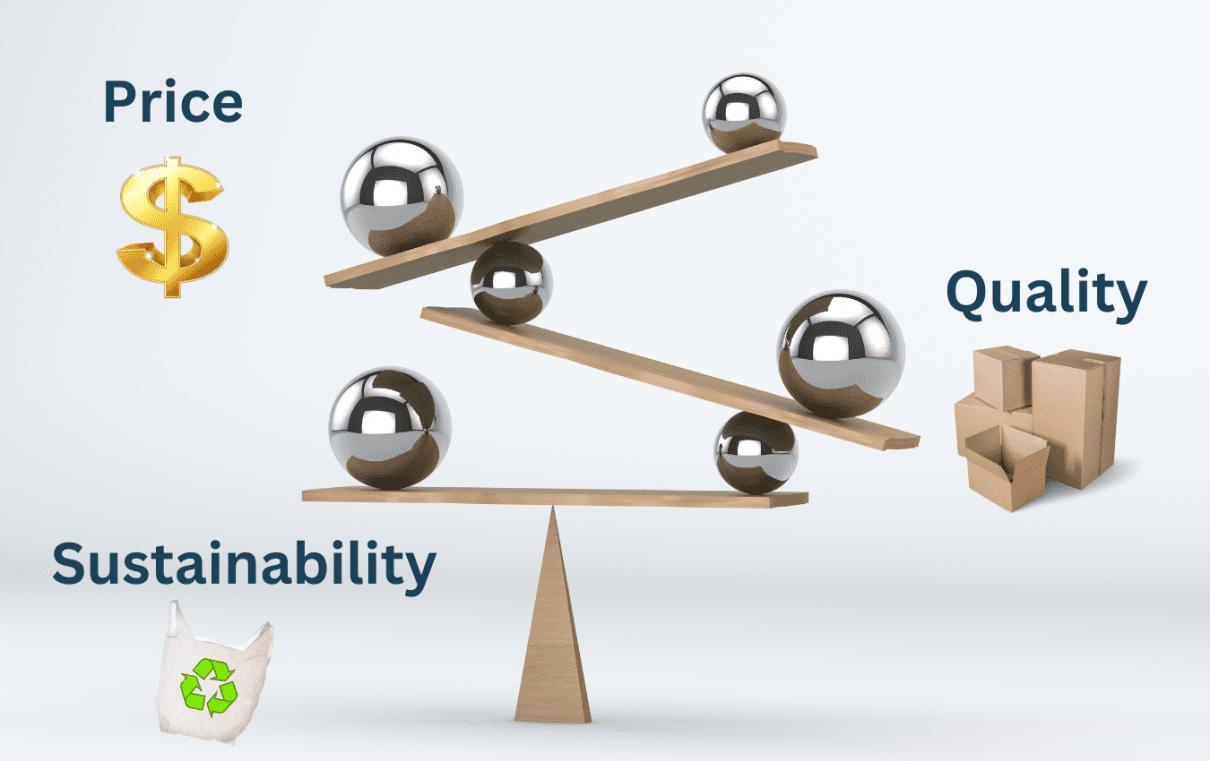Home » Packaging: Balancing Price, Sustainability, and Quality
Packaging: Balancing Price, Sustainability, and Quality

Packaging is a critical component of our daily lives, serving a dual purpose of protecting products and conveying vital information to consumers. In the wake of growing environmental concerns, the selection of packaging materials has become a focal point. In this blog, we will delve into the intricate interplay between price, sustainability, and quality in packaging.
Price
Price typically takes center stage for businesses when they contemplate packaging materials. It wields a direct impact on the financial bottom line and is a key determinant of profitability. Let’s dissect the pricing considerations for various packaging materials:
Flexible Plastic:
- Flexible plastic packaging is often the most economical choice. Its production cost is low, and its lightweight nature reduces transportation expenses. It is important to recognize that generic non-flexible plastic packaging can be more expensive depending on the application.
- Bulk purchasing of flexible plastic packaging materials is budget-friendly.
- Nevertheless, a holistic cost analysis should factor in long-term expenses, including disposal and potential harm to a brand’s reputation due to environmental concerns.
Corrugated:
- Corrugated packaging materials are generally cost-effective but may sometimes surpass flexible plastic packaging in terms of pricing.
- Customization or printing on corrugated packaging can incrementally raise costs.
- Opting for recycled corrugated materials not only contributes to cost efficiency but also promotes sustainability.
Chipboard and Paperboard:
- Chipboard and paperboard packaging materials tend to offer an economical solution.
- Their competitive pricing, coupled with their adaptability and versatility, make them suitable for a wide spectrum of products.
- Utilizing recycled chipboard and paperboard further enhances their cost-effectiveness and sustainability.
Flexible Plastic
Corrugated
Chipboard/Paperboard
Sustainability
As global environmental consciousness continues to rise, sustainability has emerged as a pivotal factor in packaging decisions. Sustainable packaging aims to minimize its ecological impact across its entire lifecycle. Here’s how different materials stack up in terms of sustainability:
Plastic:
- Traditional plastic packaging is often criticized for being non-biodegradable and for exacerbating plastic pollution.
- However, innovations such as biodegradable plastics and recycled PET offer more sustainable alternatives.
Corrugated:
- Corrugated packaging is generally regarded as a more sustainable option, especially when sourced from responsibly managed forests or containing recycled content.
- Its biodegradability and ease of recycling bolster its eco-friendly credentials.
Chipboard and Paperboard:
- Chipboard and paperboard packaging materials inherently possess sustainability attributes, often originating from renewable sources like wood pulp.
- Their recyclability and biodegradability make them environmentally responsible choices.
Quality
Packaging quality plays a pivotal role in safeguarding products, preserving their integrity, and enhancing the overall customer experience. Here’s how different materials perform concerning quality:
Plastic:
- Plastic packaging excels in protecting products from moisture and is highly resistant to breakage.
- However, it may not be suitable for products requiring breathability or specific temperature conditions.
Corrugated:
- Corrugated packaging offers versatility and can be tailored to accommodate various product types.
- It is particularly well-suited for dry goods and provides robust protection when designed effectively.
Chipboard and Paperboard:
- Chipboard and paperboard packaging are renowned for their adaptability and quality, making them suitable for a diverse range of products.
- They excel in maintaining product integrity and are an excellent choice for items sensitive to light or air.
If you are looking for custom packaging solutions tailored to your needs, then partner with Brown Packaging today to get started.
Why Co-Packaging Becomes Critical During the Holidays As the holiday season approaches, packaging teams are under pressure to deliver high volumes of promotional sets, combo
Holiday demand starts long before December. So should your packaging. For B2B and D2C brands alike, Q4 is the most critical—and most chaotic—shipping window of
The Challenge of Multi-SKU Holiday Programs During the holiday season, brands often shift from selling single products to curated sets, bundled assortments, and promotional kits—each
Rigid boxes are the gold standard of premium packaging. Whether used for cosmetics, electronics, fashion, or high-end subscription kits, rigid boxes do more than protect
Understanding One-Piece FOL and Three-Piece Bike Shipping Boxes Choosing the right box style is essential when shipping bicycles—especially for brands, manufacturers, and distributors focused on
Corrugated boxes are essential to shipping, retail, and e-commerce—but when you introduce custom printing, the stakes (and the opportunities) rise. Print isn’t just about looks—it’s
Home » Packaging: Balancing Price, Sustainability, and Quality
Effective packaging can play a critical role in the success of any business. The right type of packaging can make all the difference when it
Retail point of purchase (POP) displays are essential tools for marketing products directly to consumers within retail environments. These displays vary widely in shape, size,
The selection of materials and the production process are critical aspects of creating a Point of Purchase (POP) display that not only captures attention but